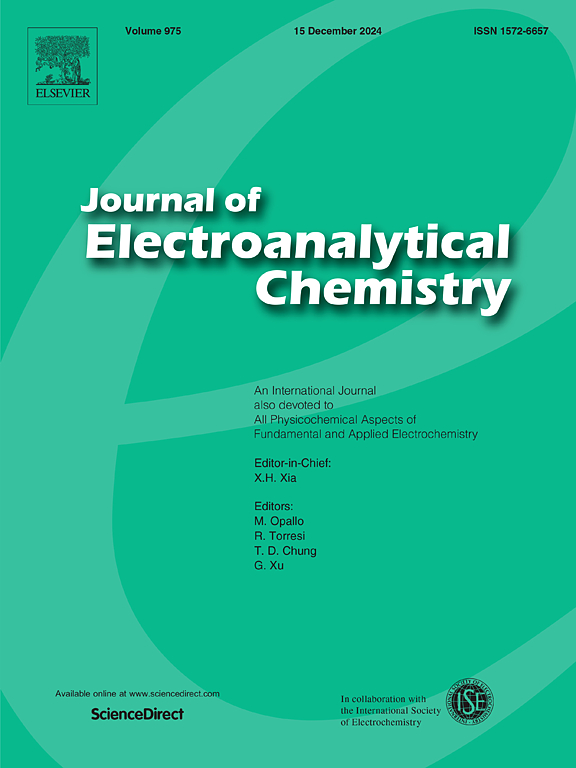Pomegranate-like cobalt Phosphides@P-Doped carbon Nanostructures with controlled phase as anode materials for Lithium-Ion batteries
IF 4.1
3区 化学
Q1 CHEMISTRY, ANALYTICAL
引用次数: 0
Abstract
Transition metal phosphides (TMPs) have recently emerged as prominent energy conversion and storage materials owing to their unique physicochemical property. Nevertheless, it’s still a difficult task to obtain phase-control of TMPs owing to multiple energetically favorable stoichiometries. Herein, a phase-controllable cobalt phosphide@C with the pomegranate core–shell structure are successfully realized by employing Co-glycerate as precursors and phytic acid (PA) as P sources, etching and coordination agents. With the presence of six phosphoryl groups and the strong coordination ability, PA allows the self-phosphating of Co atoms and the P-doped carbon shell, as well as the confinement of the obtained nanoparticles Additionally, as an organic acid, PA can etch the Co-glycerate precursors with the formation of hollow structures. With different etching time, metal-rich phosphides Co2P@C and monophosphides CoP@C are successfully achieved. When applied as anode materials, CoP@C demonstrates superior lithium storage performance by delivering a prominent reversible capacity up to 1187 mAh/g at 0.1 A/g and shows no capacity loss at 1 A/g after 500 cycles. This work presents a simple protocol to obtain TMPs with tunable metal/phosphorus ratios, phase selectivity and interface engineering, which could be applied in the field of energy storage and electrocatalysis.
作为锂离子电池负极材料的石榴状磷化钴@P-掺杂碳纳米结构的可控相位
过渡金属磷化物(TMPs)因其独特的物理化学特性,近来已成为一种重要的能量转换和储存材料。然而,由于存在多种能量上有利的化学计量,要获得过渡金属磷化物的相位控制仍然是一项艰巨的任务。本文以钴-甘油酸酯为前驱体,植酸(PA)为P源、刻蚀剂和配位剂,成功实现了具有石榴核壳结构的可相控磷化钴@C。此外,作为一种有机酸,植酸可以蚀刻钴甘油酯前驱体并形成中空结构。在不同的蚀刻时间下,成功实现了富金属磷化物 Co2P@C 和单磷化物 CoP@C。在用作正极材料时,CoP@C 表现出卓越的锂存储性能,在 0.1 A/g 时可提供高达 1187 mAh/g 的显著可逆容量,并且在 1 A/g 循环 500 次后无容量损失。这项研究提出了一种简单的方法来获得具有可调金属/磷比例、相选择性和界面工程的 TMPs,可应用于储能和电催化领域。
本文章由计算机程序翻译,如有差异,请以英文原文为准。
求助全文
约1分钟内获得全文
求助全文
来源期刊
CiteScore
7.80
自引率
6.70%
发文量
912
审稿时长
2.4 months
期刊介绍:
The Journal of Electroanalytical Chemistry is the foremost international journal devoted to the interdisciplinary subject of electrochemistry in all its aspects, theoretical as well as applied.
Electrochemistry is a wide ranging area that is in a state of continuous evolution. Rather than compiling a long list of topics covered by the Journal, the editors would like to draw particular attention to the key issues of novelty, topicality and quality. Papers should present new and interesting electrochemical science in a way that is accessible to the reader. The presentation and discussion should be at a level that is consistent with the international status of the Journal. Reports describing the application of well-established techniques to problems that are essentially technical will not be accepted. Similarly, papers that report observations but fail to provide adequate interpretation will be rejected by the Editors. Papers dealing with technical electrochemistry should be submitted to other specialist journals unless the authors can show that their work provides substantially new insights into electrochemical processes.

 求助内容:
求助内容: 应助结果提醒方式:
应助结果提醒方式:


